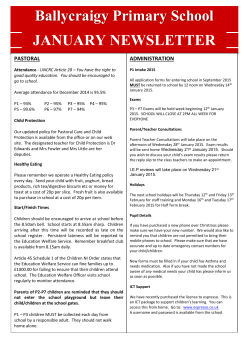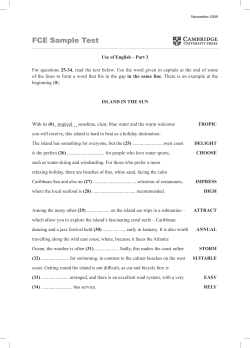
this invitation
From the Chairman, Committee for Ireland – JOHN FAULKNER Drumherriff Lodge, 37 Old Orchard Road, Loughgall, Armagh BT61 8JD jsf@globalnet.co.uk Come and be our guest, when BSBI holds its Annual Summer Meeting at Coleraine on the north coast of Ireland, on 12-16th June. If you go north on the B62 from Ballymoney, the ground rises gently. To your left is farm land; to your right the flat expanse of Garry Bog, with the Antrim hills in the distance. Ahead, the horizon is indistinct, enticing, ominous: the distance is all sky, as if to warn that you are heading for the edge of the world. Geologists tell us that, sixty million years ago, you would have been in a vast expanse of volcanic activity as basaltic lava seeped relentlessly from cracks in the earth’s crust. The alternative story is that the landscape was the handiwork of a giant, Finn McCoul. Finn’s enemies were Scottish giants. One of them, Benandonner, came across a track made by Finn, from Ireland to Scotland, but had been frightened off by tall stories told him by Finn’s wife. To hasten him on his way, Finn gouged out a great chunk from the middle of Ulster and hurled it at the Scottish giant, but it fell into the middle of the Irish Sea, creating the Isle of Man. His track to Scotland was later flooded by the sea, leaving a remnant we call the Giant’s Causeway. The Causeway is now a World Heritage Site and major tourist attraction. Much of the coast is dominated by basalt cliffs, with stretches where the underlying Ulster White Limestone presents a stark and impressive contrast to the dark basalt. The basalt forms a plateau stretching from the east coast of Co. Antrim to the centre of Co. Londonderry, with a wide, shallow dip in which lies the valley of the River Bann. Coleraine itself is close to the mouth of the Bann, a large river whose catchment drains most of central Ulster including Lough Neagh. Around the mouth of the Bann, and to the west at the entrance to Lough Foyle there are extensive beaches and sand dune systems. Inland, there are glens dissecting the plateau, with remnants of natural woodland. On level ground, either side of the River Bann, are some of the best preserved patches of lowland raised bog in the British Isles. Plant-wise, there are many specialities from Mertensia maritima (Oysterplant) on the shore to alpines like Silene acaulis (Moss Campion) growing at an unusually low altitude on Binevenagh. There is Equisetum variegatum (Variegated Horsetail) on slacks at the Umbra, and a multitude of orchids on the dune systems. One plant familiar to visitors from Britain but a real rarity as a native Irish plant is Geranium pratense (Meadow Cranesbill), found in a very restricted area near the North Antrim coast. Another speciality, for the sharp-eyed, is Melampyrum sylvaticum (Small Cow-wheat). In case you are wondering, I can reassure you that Irish hospitality has improved since Finn’s time, so we are anticipating lots of demand. Book your place now … but to be on the safe side, use an alias if your name happens to be Benandonner.
© Copyright 2025
















